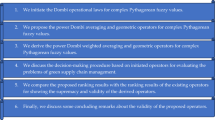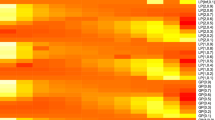Abstract
Data envelopment analysis (DEA) is an important managerial tool for evaluating the performance of decision-making units (DMUs). The conventional DEA models are mostly in the static environment using deterministic/crisp data for input and output parameters. However, in real situations, input and output data cannot always be obtained accurately because of vagueness due to fluctuating market conditions. Such vagueness in input and output data can be tackled with fuzzy numbers. So, the aim of the current study is to extend the crisp DEA into fuzzy DEA (FDEA). In this study, the input and output data are considered as fuzzy numbers (FNs), particularly the triangular fuzzy numbers (TFNs). Then, a multi-objective approach is developed to solve the FDEA model to measure the performance efficiencies of DMUs. Further, the DMUs are ranked according to their efficiencies obtained. Finally, the developed FMODEA model and rankings of DMUs are illustrated with an application on real data 13 educational institutions in India.



Similar content being viewed by others
References
Arcelus FJ, Coleman D (1995) An efficiency review of university departments. University of New Brunswick, Faculty of Administration
Arya A, Yadav SP (2018) Development of fdea models to measure the performance efficiencies of dmus. Int J Fuzzy Syst 20(1):163–173
Banker RD, Charnes A, Cooper WW (1984) Some models for estimating technical and scale inefficiencies in data envelopment analysis. Manage Sci 30(9):1078–1092
Boubaker S, Do DT, Hammami H, Ly KC (2020) The role of bank affiliation in bank efficiency: a fuzzy multi-objective data envelopment analysis approach. Ann Oper Res 1–29
Breu TM, Raab RL (1994) Efficiency and perceived quality of the nation’s “top 25” national universities and national liberal arts colleges: an application of data envelopment analysis to higher education. Socio Econ Plann Sci 28(1):33–45
Charnes A, Cooper WW, Rhodes E (1978) Measuring the efficiency of decision making units. Eur J Oper Res 2(6):429–444
Chen W, Li SS, Zhang J, Mehlawat MK (2020) A comprehensive model for fuzzy multi-objective portfolio selection based on dea cross-efficiency model. Soft Comput 24(4):2515–2526
Cooper WW, Seiford L, Tone K (2000) Data envelopment analysis: theory, methodology, and applications, references and dea-solver software
Ghasemi MR, Ignatius J, Lozano S, Emrouznejad A, Hatami-Marbini A (2015) A fuzzy expected value approach under generalized data envelopment analysis. Knowl Based Syst 89:148–159
Guo P (2009) Fuzzy data envelopment analysis and its application to location problems. Inform Sci 179(6):820–829
Guo P, Tanaka H (2001) Fuzzy dea: a perceptual evaluation method. Fuzzy Sets Syst 119(1):149–160
Guo P, Tanaka H (2008) Decision making based on fuzzy data envelopment analysis. In: Intelligent decision and policy making support systems. Springer, pp 39–54
Hatami-Marbini A, Emrouznejad A, Tavana M (2011) A taxonomy and review of the fuzzy data envelopment analysis literature: two decades in the making. Eur J Oper Res 214(3):457–472
Kao C, Liu ST (2000) Fuzzy efficiency measures in data envelopment analysis. Fuzzy Sets Syst 113(3):427-437
Kumar H, Singh AP, Yadav SP (2019) Nsga-ii based analysis of fuzzy multi-objective reliability-redundancy allocation problem using various membership functions. INAE Lett 4(3):191–206
Lertworasirikul S, Fang SC, Joines JA, Nuttle HL (2008) A possibility approach to fuzzy data envelopment analysis. In: JCIS, pp 176–179
Marler RT, Arora JS (2010) The weighted sum method for multi-objective optimization: new insights. Struct Multidisc Optim 41(6):853–862
Mogha SK, Yadav SP, Singh S (2014) New slack model based efficiency assessment of public sector hospitals of uttarakhand: state of India. Int J Syst Assur Eng Manage 5(1):32–42
Mogha SK, Yadav SP, Singh S (2016) Estimating technical efficiency of public sector hospitals of Uttarakhand (India). Int J Oper Res 25(3):371–399
Puri J, Yadav SP (2013) Performance evaluation of public and private sector banks in India using dea approach. Int J Oper Res 18(1):91–121
Puri J, Yadav SP (2015) A fully fuzzy approach to dea and multi-component dea for measuring fuzzy technical efficiencies in the presence of undesirable outputs. Int J Syst Assur Eng Manage 6(3):268–285
Sengupta JK (1992) A fuzzy systems approach in data envelopment analysis. Comput Math Appl 24(8–9):259–266
Tavana M, Khalili-Damghani K, Arteaga FJS, Hosseini A (2019) A fuzzy multi-objective multi-period network dea model for efficiency measurement in oil refineries. Comput Indus Eng 135:143–155
Tyagi P, Yadav SP, Singh S (2009) Relative performance of academic departments using dea with sensitivity analysis. Eval Program Plann 32(2):168–177
Wang YM, Luo Y, Liang L (2009) Fuzzy data envelopment analysis based upon fuzzy arithmetic with an application to performance assessment of manufacturing enterprises. Exp Syst Appl 36(3):5205–5211
Wang WK, Lu WM, Liu PY (2014) A fuzzy multi-objective two-stage dea model for evaluating the performance of us bank holding companies. Exp Syst Appl 41(9):4290–4297
Wen M, You C, Kang R (2010) A new ranking method to fuzzy data envelopment analysis. Comput Math Appl 59(11):3398–3404
Zamani P (2020) The position of multiobjective programming methods in fuzzy data envelopment analysis. Int J Math Modell Comput 10(2 (SPRING)):95–101
Zimmermann HJ (2011) Fuzzy set theory-and its applications. Springer Science & Business Media
Acknowledgements
The authors are thankful to The Ministry of Education, the Govt. of India, for financial support in pursuing this research.
Author information
Authors and Affiliations
Contributions
All persons who meet authorship criteria are listed as authors, and all authors certify that they have participated sufficiently in the work to take public responsibility for the content, including participation in the concept, design, analysis, writing or revision of the manuscript. Furthermore, each author certifies that this material or similar material has not been and will not be submitted to or published in any other publication.
Ethics declarations
Conflict of interest
Authors declare that they have no conflict of interest.
Ethical approval
This article does not contain any studies with human participants performed by any of the authors.
Additional information
Publisher's Note
Springer Nature remains neutral with regard to jurisdictional claims in published maps and institutional affiliations.
Rights and permissions
About this article
Cite this article
Singh, A.P., Yadav, S.P. & Singh, S.K. A multi-objective optimization approach for DEA models in a fuzzy environment. Soft Comput 26, 2901–2912 (2022). https://doi.org/10.1007/s00500-021-06627-y
Accepted:
Published:
Issue Date:
DOI: https://doi.org/10.1007/s00500-021-06627-y




